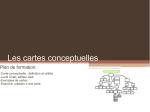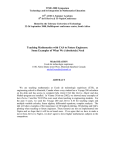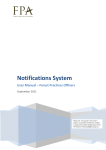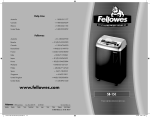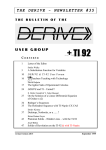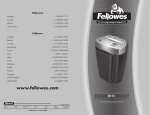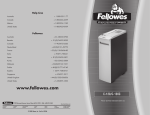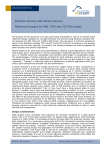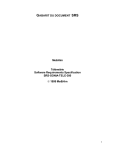Download y - TIME 2010
Transcript
Technology and its Integration into Mathematics Education July 6th‐10 July 6 10th, 2010 2010 E. T. S. I. Telecomunicaciones, Málaga, Spain Who I Am, What I Do Mathematics p professor at ETS (engineering school) since 1991: single and multiple variable calculus, differential equations, linear algebra, complex analysis. analysis I started to use Derive in 1991 and I continue to use it today. 2 Who I Am, What I Do With the venue of the TI-92, the real possibilities of using computer algebra IN THE CLASSROOM were finally fi ll unified. ifi d 3 Who I Am, What I Do In an engineering g g school,, it was natural to use an affordable CAS: since 1999, each undergraduate student at ETS has to buy a TI-92 Plus (nowVoyage 200). http://www.seg.etsmtl.ca/ti/home.html 4 Who I Am, What I Do In myy engineering g g school,, we have a great privilege: being able to use Computer Algebra in the classroom classroom, when we want and during exams, all semester long. long We don’t have to block internet access, Voyage 200 remains a “calculator”. 5 Who I Am, What I Do Organizing TIME 2004 and ACA 2009 conferences would have been impossible without them: Gilles Picard Kathleen Pineau 6 Who I Am, What I Do My (same and only) wife since 32 years: 7 Who I Am, What I Do But my main occupation for the past 2 years... 8 9 Ideas and Themes of the Presentation Ideas and Themes of the Presentation • Theme A: We can teach mathematics with a CAS. Instead of removing items from the curriculum we should revisit it with the CAS curriculum, (example 1: V200, Nspire CAS). With a CAS, you can (sometimes) solve the same problem, using 2 different approaches (examples 2 and 3: V200, Derive). 10 Ideas and Themes of the Presentation Ideas and Themes of the Presentation • Theme B: CAS are powerful but the teacher p remains important. If the h CAS you are using i ddoes not hhave some built-in function, (sometimes) you can overcome this by using an appropriate approach (examples 4 and 5: Derive, V200). 11 Ideas and Themes of the Presentation Ideas and Themes of the Presentation • Theme C: When computer algebra and theory become partners. p Some years ago, iit was not easy to keep S k students’ interest for concepts in analysis or linear algebra. To much theory, not enough practice, no graphs (examples 6 and 7: Nspire CAS, Derive). 12 Comment about the examples to come These h selected l d examples l are coming i from f my daily teaching/exchanges with colleagues at ETS and David Jeffrey from UWO. This means th Thi thatt th the level l l off mathematics th ti involved is the one at university level, for engineering i i studies. t di But, B t one can easily il apply l it to any level of teaching. 13 Comment about the examples to come Some examples will be (now have been) pperformed live: if someone would like to obtain a file showing the details, please email michel beaudin@etsmtl ca [email protected]. 14 Theme A We can teach with CAS • Example 1 At ETS, some colleagues don’t teach partial fractions anymore. Some never g of trigg expressions. p sayy a word about integrals Why? You can do so much with a CAS. Consider these expressions x , 4 3 2 3 x + 5 x + 25 x + 45 x − 18 sin 6 x. 15 16 17 18 • Example 2: In the same course, we should try to link different subjects and show the students how to use their handheld. For example example, let let’ss solve solve, using power series, the following problem: (2 x − 11) y′′ − y′ − 3xy = 0, y (0) = 10, y′(0) = 4. Then,, we will use it to estimate y( y(3). ) 19 ∞ Series solution: y ( x) = ∑ cn x n = c0 + c1 x + c2 x 2 + L ( with c0 = 10 and n =0 c1 = 4 ) . Byy hand,, the students will find the followingg recurrence formula: cn 2n ( = 2 − 7n + 5 ) cn −1 − 3cn −3 11n(n − 1) Then c2 = − 2 11, c3 = −167 363, c4 = − 651 5324,K 20 If we use only the first 5 terms, terms we will conclude that y(3) = −1.96. Butt the B th correctt answer is i y(3) (3) = 2.04. 2 04 St Students d t can obtain this answer with the help of their device device. − H iis hhow. Here 21 Voyage 200 has a SEQ graphic mode. Let’s use it: 22 Voyage 200 also has a DIFF EQUATIONS ggraphic p mode. We have to convert (by ( y hand)) the second order ODE into a first order system: ⎧ y′ = z ⎪ z + 3 xy ⎨ ′ z = 2 x − 11 ⎩⎪ y (0) = 10, z (0) = 4 23 We type the system into the Y Editor, Editor plot the graph of y1 (the solution) and observe the value l off y(3) (3) ((RK method h d iis being b i used, d here): h ) So the value y(3) = 2.04 is correct! 24 • Example 3 Why not use the power of the CAS? Especially for Derive, its ability to i t integrate t piecewise i i continuous ti functions. f ti y solution of the followingg Find the steady-state problem: y′′ + 2 y′ + y = f (t ), y(0) = 0, y′(0) = 0, ⎧ sin( t ) f (t ) = ⎨ ⎩ 0 0<t<π π < t < 2π f ( t + 2 π ) = f ( t ). ) 25 One can show, using the undetermined coefficients method and Fourier series,, that the (particular) steady-state solution looks like this: 26 But, according to Laplace transform theory, the given byy a convolution whole solution is g integral: If y′′ + 2y′ + y = f (t)), y(0) = 0, 0 y′(0) = 0,then 0 then t y(t) = h(t) ∗ f (t) = ∫ h(τ ) f (t −τ ) dτ , where h(t) = te−t . 0 p transform ⎛ This is because the inverse Laplace ⎜ 2 −t ⎜ + + of 1 s 2 s 1 is te . ( ) ⎝ ⎞ ⎟ ⎟ ⎠ 27 No one will try to compute the convolution integral by hand (and how can we define easily a non trivial t i i l periodic i di input?). i t?) p the We can use Derive in order to compute convolution of f and h. Let us recall that ⎧ sin( t ) f (t ) = ⎨ ⎩ 0 0<t<π π < t < 2π f ( t + 2 π ) = f ( t ). h ( t ) = te − t . 28 Theme B My CAS can’t do this... What can I do? • Example 4 There is no “LambertW” function p into Derive. And no built-in implemented Dirac Delta “function”. How can you deal with this? Let us show that these absent functions can be turned into a better understanding of some mathematical concepts. 29 Let’s L t’ find fi d all ll reall solutions l ti andd one complex l solution for the equation 2x = x10. Note: some systems (Maple for example) can solve this equation because they have defined a special function (Lambert W) which is the p( ) inverse function of f ((x)) = x exp(x). 30 Now let’s solve the differential equation y′′ + 4 y = 50 δ (t − π ), y (0) = 10, y ′(0) = 5. Note: the “Dirac delta” function δ(t− τ) can be seen as a limit of indicator function over a very small interval of time with area 1. 1/ε CHI(τ, t, τ + ε) in Derive. 31 “dsolve2 dsolve2_iv( iv( p, p q, q r, r t, t to, to yo, yo vo) vo)” is the command that solves the second order linear differential equation in Derive. y′′ + p (t ) y′ + q (t ) y = r (t ), y ( t0 ) = y0 , y′ ( t0 ) = v0 . y′′ + 4 y = 50 δ (t − π ), y (0) = 10, y′(0) = 5. Derive is using the method of variation of parameters, which involves the computation of integrals ... And Derive has no problem to i t integrate t piecewise i i functions! f ti ! 32 Example 5 Using Voyage 200, how can I find the coordinates of the ppoint of intersection of two parametric 2D defined curves? The F5 Math menu shows the item “Intersection” in Function graphic mode only... 33 L t’ see this, Let’s thi using i Voyage V 200 : 34 Theme C Theory and CAS (Since OS 1.7) Nspire CAS has a “Generalized Series” built-in function: 35 • Example 6 Question from complex analysis. Compute p the followingg line integral: g I≡ ∫ f ( z ) dz , C the boundary of the square C with vertices ± 3 ± 3i, and f ( z) = cos(( z ) + sinh i h ( z) ( ) z2 −1 3 . 36 We usually compute this kind of integral using the residue integration method. If f has an isolated singularity at z0 and Laurent expansion f (z) = ∞ ∑ cn ( z − z0 ) n for 0 < z − z0 < R, n=−∞ then the coefficient c−11 is called the residue of f at z0. 37 By the residue theorem theorem, we have I = 2π i ( B1 + B2 ) where B1 = residue at the triple pole z = 1 and B2 = residue at the triple pole z = −1. f ( z) = cos( z ) + sinh ( z ) ( z − 1) 2 3 e − 7e−1 Nspire CAS will show that B1 + B2 = . 16 ⎛ e − 7e −1 ⎞ So,, I = ⎜⎜ ⎟⎟ 2π i ≈ 0.056i. ⎝ 16 ⎠ 38 But we can also use the definition of a line integral. Of course, it would be long to integrate over each side of the square... Using the principle of deformation of paths, paths wee can impose a continuous deformation of the square into the circle of radius 2, 2 located at the origin: f ( z) = cos( z ) + sinh ( z ) ( ) z2 −1 3 39 This means that we can compute the value of the integral by using the definition. b ∫ f (z) dz = ∫ f ( r(t)) r′(t) dt r where r :[ a,b] → a is a smooth curve in the plane. Let’s use r(t) =2exp(it) for the circle of radius 2 centeredd at 0. 2, 0 Now take a look at the power of Nspire CAS! 40 • Example 7 The importance to see it. In Derive, Derive ROTATE_X( ROTATE X(θ) simplifies to a matrix A such that A·v rotates the 3D coordinate vector v through an angle of θ radians about the x-axis, counterclockwise when viewed from the positive x-axis toward g the origin. Can we see an example? 41 Conclusion What are the main benefits of using technology i the in th classroom? l ? S Some ((personal) l) answers. 42 Computer algebra allows me to continue to teach (almost) the same courses with a taste of ) new: “make new from old” ((Josef Böhm). Thi situation This it ti has h many advantages, d t namely: l – Retirement can wait. – I can revisit some mathematical results. – When I have to prepare new material material, CAS explorations are helping me. 43 But using technology has also some disadvantages: g – Weaker students can succeed thanks to the CAS. – Is this really a problem? – In some cases, less time CAN be spent on proving results l because b more time i MUST be b spent on learning how to use the CAS. 44 This is why we need a “good good mathematical assistant”. As far as I am concerned, Derive, Voyage 200 and Nspire CAS are in this category. And don’t forget this (adapted from the Derive user manual). 45 “Making Making mathematics more exciting and enjoyable should be the driving force behind the development of a CAS program program.” “It gives you the freedom to explore different approaches to problems ... Something you probably would never consider if you had to d th do the calculations l l ti by b hand”. h d” 46 But I have to tell you something: why do I like so much to attend TIME conferences? Or why Computer Algebra is so powerful according to me? It ggives me the chance to meet nice people p p ((or,, at least, think of them). 47 48 I have the opportunity to travel very far and have beer with friends: 49 Very far from Montreal. 50 I can see (almost yearly) very SERIOUS co eagues: colleagues: 51 EXTREMELY serious colleagues: 52 Thank You! Thank You! 53



























